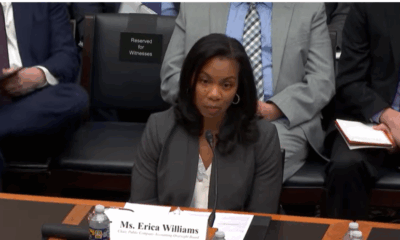Flags outside the Fairmont Royal York in downtown Toronto, Feb. 3, 2025.
Andrew Francis Wallace | Toronto Star | Getty Images
A complicated scenario is emerging surrounding the tariff drama that could put the Federal Reserve in an uncomfortable Catch-22, unsure whether to use its policy levers to tame inflation or boost growth.
With many bridges to cross yet in President Donald Trump‘s efforts to use the levies as a tool both of foreign and economic policy, the central bank will have a delicate balance to strike.
Many economists expect the tariffs both to raise prices and shave the pace of gross domestic product, with the main question being a matter of degree on the extent of any need for Fed policy adjustments.
“Maybe you get that price shock and maybe it’s offset by the dollar going up vs. the currencies of the countries subject to tariffs. But just really the long-term effects tend to be negative for growth,” said Kathy Jones, chief fixed income strategist at Charles Schwab. “You put that combination together and it puts the Fed in a real bind.”
There are a lot of moving parts happening in the dispute Trump is having with China, Canada and Mexico, the three leading U.S. trade partners. As things stand now, threatened duties against Canada and Mexico have been postponed as the president negotiates with leaders of those governments. But the situation with China has quickly escalated into a tit-for-tat conflict that has markets on edge.
A different history
That tariffs cause higher prices is practically an article of faith for economists, though the historical record provides less certainty. The Smoot-Hawley tariffs in 1930, for instance, actually proved to be deflationary as they helped worsen the Great Depression.
When Trump launched tariffs in his first term, inflation was low and the Fed was raising rates as it sought a “neutral” level. A manufacturing recession ensued in 2019, though one that did not spread to the broader economy.
This time around, the targeted tariffs that Trump had previously used have been replaced by the threat of blanket duties that could change the monetary policy calculus. Schwab projects that the tariffs at full strength could cut 1.2% off GDP growth while adding 0.7% to core inflation, pushing the latter measure above 3% in the months ahead.
Broader tariffs “have both more price impact and more growth impact down the road,” Jones said. “So I could see [the Fed] staying on hold longer, with the threat of tariffs hanging over the market and maybe seeing these price increases and then having to pivot to easing later in the year, or next year, or [whenever] that growth impact shows up.”
“But they’re definitely in a tough spot right now, because it’s a two-sided coin,” she added.
Indeed, markets largely expect the Fed to hold tight for at least the next several months as policymakers observe the reality against the rhetoric on tariffs, along with looking for the impact from a full percentage point of interest rate cuts in the final four months of 2024.
If any of the parties blink on tariffs, or if they are less inflationary than thought, the Fed can go back to focusing on the employment side of its dual mandate and pivot away from inflation concerns.
“They’re very comfortably on hold right now, and the back and forth on tariffs won’t impact that, especially since we don’t even know what they’re going to look like,” said Eric Winograd, director of developed market research at AllianceBernstein. “You’re talking multiple months before this will meaningfully impact their thinking.”
‘A lot of uncertainty’
Winograd is among those who think that while tariffs could result in one-off boosts to some prices, they will not generate the kind of underlying inflation that Fed officials look at when making policy.
That matches some of the recent statements from Fed officials, who say that tariffs are likely only to affect their decision-making if they generate a full-blown trade war or somehow contribute to more fundamental supply or demand drivers.
“There’s a lot of uncertainty about how policies unfold, and without knowing what actual policy will be implemented, it’s just really not possible to be too precise about what the likely impacts are going to be,” Boston Fed President Susan Collins told CNBC in an interview on Monday. From a policy perspective, Collins said her current stance is to “be patient, careful, and there’s no urgency for making additional adjustments.”
Market pricing is still pointing to a likely Fed rate cut at the June meeting, then possibly one more quarter percentage point reduction in December. The Fed last week opted to hold the federal funds rate steady in a range between 4.25%-4.5%.
Winograd said he sees a scenario where the Fed can cut two or three times this year, though not starting until later as the tariff situation plays out.
“Given how insulated the U.S. economy generally is from trade frictions, I don’t think it moves the Fed needle very much,” Winograd said. “The market is presuming too mechanical of a reaction function from the Fed where if they see inflation go up, they have to respond to it, which simply isn’t true.”

 Accounting1 week ago
Accounting1 week ago
 Economics1 week ago
Economics1 week ago
 Personal Finance1 week ago
Personal Finance1 week ago
 Accounting1 week ago
Accounting1 week ago
 Finance1 week ago
Finance1 week ago
 Economics1 week ago
Economics1 week ago
 Economics1 week ago
Economics1 week ago
 Economics1 week ago
Economics1 week ago






















